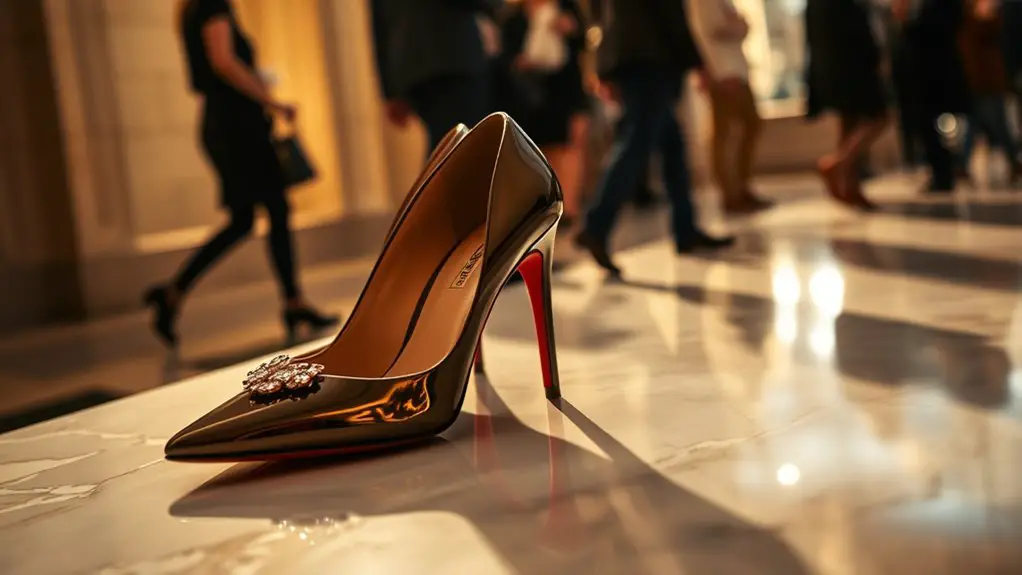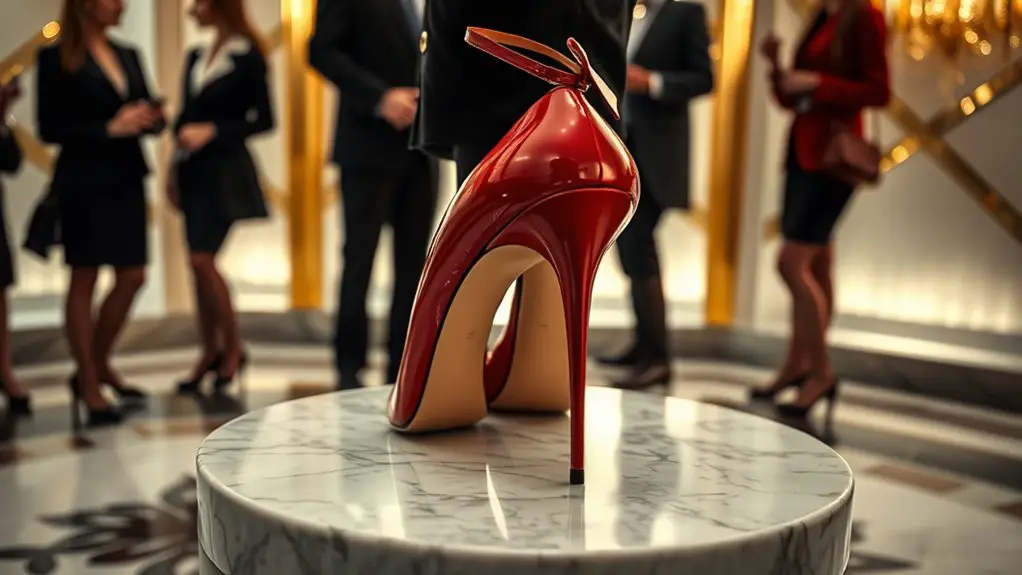High heels evolved from practical footwear to status symbols through historical and cultural transformations. In the 17th century, they became associated with aristocracy, signaling wealth and authority. As the 19th century embraced feminine fashion, high heels reinforced gender dynamics, intertwining beauty norms with social standing. Hollywood further cemented their allure, making them icons of glamour. Their complex role in shaping identity and power dynamics invites questions about their impact on modern culture and personal expression, revealing deeper insights.
The Origins of High Heels: A Practical Necessity

Although high heels are often viewed as a contemporary fashion statement, their origins can be traced back to practical needs. Initially, high heels served a functional purpose, rooted in historical necessity. In ancient civilizations, such as Egypt and Persia, elevated footwear was designed to protect the feet from rough terrain and enhance stability while riding horses. This practical design evolved over time, as the association with power and status became more pronounced.
As you explore the development of high heels, you’ll notice how these shoes changed from mere utilitarian objects to symbols of sophistication. The elevation offered by high heels not only improved visibility in social settings but also conveyed an air of authority. Consequently, high heels emerged not just as a fashion item but as an embodiment of societal values and expectations, firmly linking their practical origins with their eventual role in the hierarchy of style.
High Heels in the 17th Century: A Symbol of Power
In the 17th century, high heels emerged as a distinctive marker of aristocratic fashion, signaling wealth and social status. Their elevation not only amplified physical stature but also reinforced the dynamics of authority and power, particularly among men. Additionally, as women adopted these heels, the interplay between gender and power became increasingly complex, reflecting societal norms of the time.
Aristocratic Footwear Fashion
High heels emerged in the 17th century as a defining feature of aristocratic fashion, serving not just as a practical accessory but also as a potent symbol of power and status. You’d see the elite sporting these elevated shoes, showcasing their wealth and social standing, steeped in royal influence.
Consider the elements of aristocratic elegance that high heels embodied:
- The intricate designs, often adorned with luxurious materials
- The vibrant colors, signaling affluence and fashion-forward thinking
- The exaggerated height that distinguished nobility from commoners
This footwear trend played a vital role in shaping perceptions of power, showcasing how a simple accessory could convey an entire narrative of dominance and prestige within society.
Height and Authority
The elevation provided by high heels in the 17th century went beyond mere aesthetics; it directly correlated with authority and social hierarchy. You’d notice that individuals of higher status often utilized height perception as a tool to convey power. High heels acted as authority signals, allowing wearers to project dominance and secure their place within the rigid social structure. This visual elevation not only distinguished the aristocracy but also reinforced societal norms where stature equated to influence. The act of wearing high heels became a deliberate choice, reflecting an understanding of how physical attributes could manipulate perceptions of power. Consequently, in this situation, high heels transformed into symbols, intertwining personal identity with societal expectations of authority.
Gender and Power Dynamics
While many associate high heels with femininity today, their origins in the 17th century reveal a complex interplay between gender and power dynamics. Initially worn by men, high heels served as a power symbolism that challenged contemporary gender roles. Aristocrats donned these elevated shoes to project authority and social status, subverting traditional masculinity.
- Elaborate designs featuring intricate embroidery
- Bold colors that signified wealth and influence
- Sturdy construction to support the wearer’s stature
As high heels became emblematic of dominance, they blurred the lines between gender identities. This evolution highlights how societal contexts shape the significance of fashion, illustrating how high heels changed from male symbols of power to the feminine adornment we recognize today.
The Shift to Feminine Fashion in the 19th Century
As societal norms evolved during the 19th century, fashion began to reflect a shift towards femininity that intertwined with emerging concepts of gender identity and social status. You’d notice that the Victorian era emphasized feminine aesthetics, with corsets and elaborate skirts becoming symbols of societal expectations for women. This period marked a change where clothing not only served practical purposes but also conveyed a woman’s social standing. High collars, intricate fabrics, and ornate designs emerged as markers of refinement, reinforcing the notion that a woman’s worth was tied to her appearance.
As you examine this evolution, it’s clear that fashion was a vehicle for expressing femininity, serving both as a means of empowerment and a constraint under rigid societal norms. The shift to feminine fashion in the 19th century laid the groundwork for future discussions about women’s identity, positioning clothing as an essential element in the negotiation of gender roles.
Hollywood’s Role in Elevating High Heels

Hollywood has considerably shaped the perception of high heels through iconic film moments that captivate audiences and set trends. Celebrity endorsements amplify this effect, as stars showcase heels as essential components of glamour and sophistication. Additionally, the red carpet serves as a powerful platform, reinforcing high heels as symbols of status and style within the cultural zeitgeist.
Iconic Film Moments
In many ways, iconic film moments have immortalized high heels as symbols of power, femininity, and allure. Through cinematic influence, these films have shaped cultural perceptions of high heels, transforming them into status symbols. Consider the following scenes:
- Carrie Bradshaw in *Sex and the City*: Strutting confidently in her Manolos, she embodies the modern woman’s aspirations.
- Dorothy’s ruby slippers in *The Wizard of Oz*: A magical representation of empowerment, illustrating the transformative power of footwear.
- Gilda’s stunning entrance in *Gilda*: Rita Hayworth’s heels become synonymous with seduction and glamour.
These iconic moments not only highlight fashion but also reflect broader societal values, cementing high heels as enduring emblems of ambition and allure in popular culture.
Celebrity Endorsements Impact
While many factors contribute to the allure of high heels, celebrity endorsements play a pivotal role in establishing these shoes as symbols of status and desirability. You can see how celebrity culture intertwines with fashion influence, as stars often don high heels on various platforms, from social media to public appearances. Their choices set trends, leading fans to imitate their styles. When a celebrity endorses a brand or wears a particular design, it instantly elevates that shoe’s desirability, transforming it into a must-have item. This phenomenon highlights the power dynamics at play, where a single endorsement can shift consumer perceptions and preferences, reinforcing the high heel’s status as a quintessential fashion statement and a marker of societal status.
Red Carpet Influence
The red carpet serves as a powerful stage for high heels, showcasing them as essential elements of celebrity fashion. Each appearance crafts new red carpet trends, influencing public perception and desire for similar styles. You can visualize:
- Striking stilettos that elongate the leg and accentuate elegance
- Bold, embellished designs that reflect personal flair and individuality
- Classic pumps that embody timeless sophistication and versatility
These moments solidify high heels as status symbols, transforming footwear into a visual statement of power and prestige. When celebrities strut in their heels, they don’t just wear fashion; they dictate trends, making high heels synonymous with success and allure. The interaction between Hollywood and high fashion continues to elevate these iconic accessories, reinforcing their cultural significance.
The Connection Between High Heels and Professional Success

High heels have long transcended mere fashion accessories; they embody a complex interplay between societal expectations and professional aspirations. In today’s corporate landscape, high heels often serve as a significant component of professional attire, symbolizing authority and competence. When you wear them, you may find that they provide a considerable confidence boost, altering not just your posture but also your perception of self-worth.
This connection between high heels and professional success can be traced back to the idea that elevated footwear conveys sophistication and ambition. Research suggests that wearing heels can enhance your presence in the workplace, making you appear more assertive and capable. However, this reliance on high heels can also perpetuate unrealistic standards of femininity in professional settings, prompting discussions about gender equity and workplace norms. Ultimately, understanding this relationship is key to maneuvering the complexities of professional image in today’s society.
High Heels as a Statement of Individuality
Wearing high heels not only aligns with professional expectations but also offers a canvas for personal expression. They allow you to showcase your unique styles, turning footwear into a statement about who you are. Each pair tells a story, reflecting your personality and aesthetic preferences.
Consider how high heels can evoke distinct images:
- A bold, red stiletto that screams confidence and assertiveness.
- Elegant, classic pumps that embody sophistication and timelessness.
- Eclectic, patterned heels that celebrate creativity and individuality.
In a world where conformity often reigns, high heels empower you to break free from the mundane. They serve as a tool for self-assertion, challenging societal norms and expectations. By choosing specific designs, colors, and heights, you’re not just following a trend; you’re declaring your identity. Fundamentally, high heels become more than mere accessories—they’re an essential aspect of your personal expression.
Cultural Variations: High Heels Around the World
While high heels are often associated with Western fashion, their significance and styles vary dramatically across different cultures. In various regions, high heels symbolize different cultural significance, influencing how they’re perceived and worn.
| Culture | High Heel Characteristics |
|---|---|
| Western | Often seen as a status symbol; styles vary from stilettos to chunky heels. |
| Middle Eastern | Traditionally worn with intricate designs; reflect wealth and elegance. |
| East Asian | Often integrated into traditional attire, like the Chinese lotus shoe, emphasizing foot binding history. |
These global styles showcase how high heels transcend mere fashion, embodying deeper societal values and identities. By examining these variations, you can appreciate how high heels serve not only as personal adornment but also as markers of cultural identity and status across the world.
The Controversy of High Heels: Empowerment vs. Oppression
Although high heels are often celebrated as symbols of empowerment and femininity, they simultaneously evoke significant debate regarding their role in perpetuating gender norms and societal expectations. The empowerment debate surrounding high heels is complex, influenced by historical context and consumerism. While many see them as fashion statements, others argue they reinforce oppressive workplace expectations.
Consider these aspects:
- Societal pressures to conform to beauty standards can feel overwhelming.
- Feminist critiques highlight the paradox of personal choice versus societal dictates.
- Health concerns related to high heel wear raise questions about well-being.
As you navigate this landscape, it’s essential to recognize that high heels embody both empowerment and oppression, shaped by cultural perceptions and individual experiences. Your choice to wear them may reflect a desire for status or simply an expression of personal style, but it’s crucial to remain aware of the broader implications.
The Evolution of High Heel Design: From Function to Fashion
The complex relationship between high heels and societal expectations has shaped their design journey from practical footwear to a coveted fashion statement. Initially, high heels served a functional purpose, providing stability and elevation. As time progressed, design innovations began to prioritize aesthetics over functionality, leading to a shift in their cultural significance.
| Functionality | Aesthetics |
|---|---|
| Stability in riding | Elegant silhouettes |
| Support for workers | Decorative elements |
| Practicality | Fashion statements |
This evolution reflects broader societal changes, where high heels increasingly symbolize status and femininity. As designers embraced new materials and technologies, the balance between functionality and aesthetics often tilted, resulting in footwear that, while visually striking, sometimes sacrificed comfort. Understanding this evolution helps you appreciate the intricate dynamics at play in high heel design today.
The Future of High Heels: Trends and Transformations
As designers embrace a rapidly evolving landscape of fashion and technology, the future of high heels stands at a fascinating crossroads. You’ll notice several emerging trends that redefine their status and functionality:
- Sustainable materials that echo a growing commitment to environmental responsibility.
- Comfort innovations integrating adaptive footwear features, ensuring wearability without sacrificing style.
- Gender neutral designs that reflect a shift toward inclusivity and broader representation in fashion.
With the rise of high heel alternatives, you can expect minimalist aesthetics to dominate, emphasizing clean lines and versatile styles. Cultural influences will continue to shape designs, integrating global motifs into contemporary pieces. Furthermore, digital fashion and virtual reality fitting experiences could revolutionize how you shop for and wear heels, allowing for personalized selections that cater to your unique preferences. In this dynamic environment, high heels may transform into symbols not only of status but also of sustainability and inclusivity.
Frequently Asked Questions
What Are the Health Risks Associated With Wearing High Heels?
Wearing high heels can lead to significant health risks, including foot pain, joint issues, and circulation problems. You may also experience ankle injuries, muscle strain, and poor spine alignment, all of which can affect overall mobility.
How Do High Heels Affect Posture and Balance?
You might think high heels enhance elegance, but they considerably disrupt posture alignment and create balance challenges. Over time, this can lead to discomfort and musculoskeletal issues, emphasizing the need for awareness in your footwear choices.
Are There High Heel Alternatives for Professional Environments?
Yes, you can opt for comfortable footwear, like stylish flats or low-heeled shoes, that maintain professionalism while enhancing comfort. These alternatives can complement professional attire without compromising your posture or overall appearance in the workplace.
What Materials Are Commonly Used in High Heel Production?
In high heel production, various leather types—like patent, suede, and nubuck—are utilized, alongside synthetic materials. The choice often influences heel heights, impacting both aesthetics and comfort, essential in professional environments where style meets functionality.
How Do Cultural Perceptions of High Heels Vary Globally?
Cultural perceptions of high heels vary greatly across regions, reflecting global trends in fashion and femininity. In some cultures, they’re symbols of empowerment, while in others, they signify oppression, showcasing their complex cultural significance.



